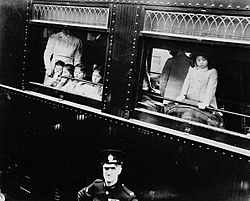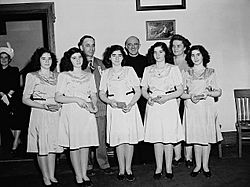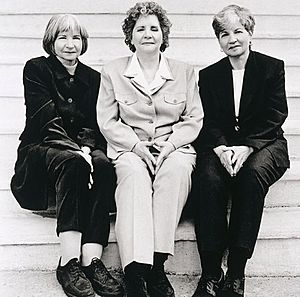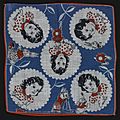Dionne quintuplets facts for kids
Quick facts for kids
Dionne quintuplets
|
|
|---|---|
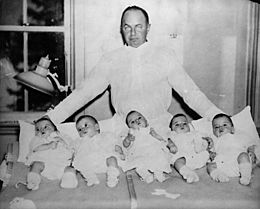
Ontario Premier Mitchell Hepburn with the Dionne babies in 1934
|
|
| Born | May 28, 1934 Callander, Ontario, Canada
|
| Died | Yvonne: June 23, 2001 (aged 67) Montreal, Quebec Émilie: August 6, 1954 (aged 20) Sainte-Agathe-des-Monts, Quebec Marie: February 27, 1970 (aged 35) Montreal, Quebec |
| Known for | Being identical quintuplets |
| Parent(s) |
|
The Dionne quintuplets are five identical sisters born on May 28, 1934. They were the first set of quintuplets known to survive infancy. These special girls were born near Callander, Ontario, in Canada. All five sisters grew up and lived into adulthood.
After living with their family for four months, the girls were placed in the care of the Red Cross. This organization paid for their needs and built a special hospital for them. Less than a year later, the government of Ontario took over their care. A law was passed making them "wards of the Crown" until they turned 18. This meant the government was their legal guardian. The government and others around them started to make money by turning the girls into a big tourist attraction.
The five identical sisters were, in order of birth:
- Yvonne Édouilda Marie Dionne (died 2001)
- Annette Lillianne Marie Allard (still living)
- Cécile Marie Émilda Langlois (still living)
- Émilie Marie Jeanne Dionne (died 1954)
- Marie Reine Alma Houle (died 1970)
Contents
Meet the Dionne Family
The Dionne family was led by Oliva-Édouard (father) and Elzire Dionne (mother). They got married on September 15, 1925. They lived on a farm near Corbeil, Ontario. The Dionnes were a French-speaking farming family.
Before the quintuplets, they already had five older children. These were Ernest, Rose Marie, Thérèse, Daniel, and Pauline. Pauline was only eleven months older than the quintuplets. The family also had three more sons after the quintuplets were born. Their names were Oliva Jr., Victor, and Claude.
Their Amazing Birth
Elzire Dionne was 24 years old when she gave birth to the quintuplets. She thought she might be having twins. No one knew that having five babies at once was even possible. The quintuplets were born early, meaning they were premature. Doctors later confirmed that the girls were identical. This means they all came from a single egg cell.
Dr. Allan Roy Dafoe helped deliver the quintuplets safely. He had first thought Elzire had a "fetal abnormality." He delivered the babies with the help of two midwives. These were Aunt Donalda and Madame Benoît Lebel. Oliva Dionne called them in the middle of the night.
The quintuplets' total weight at birth was about 6 kilograms (13 pounds, 6 ounces). The heaviest baby was 3 pounds 4 ounces. The lightest was 2 pounds 4 ounces. Their exact individual weights were not written down. The babies were immediately wrapped in warm cloths. They were kept warm in a wicker basket by the stove.
They were massaged with olive oil every two hours. For the first day, they were fed water with corn syrup. The next day, they were moved to a larger basket. They were kept warm with hot-water bottles. They were watched constantly. They were fed a special formula of cow's milk, boiled water, and corn syrup.
News of the unusual birth spread very quickly. People from all over North America offered help. Some sent supplies and advice. One hospital sent two incubators. Women also donated their breast milk to help feed the babies. They were paid for their milk, which helped families during the Great Depression. Dr. Alan Brown made sure breast milk was delivered to the quintuplets every morning by train.
Becoming Wards of the Crown
Soon after the girls were born, people who organized fairs wanted to display them. This was to show them to the world. At that time, it was common for "incubator babies" to be shown at fairs. The parents were convinced to agree by Dr. Dafoe and the family priest.
However, Oliva Dionne soon changed his mind. He said his wife had not signed the contract, so it was not valid. Around July 1934, the parents signed custody of the quintuplets over to the Red Cross for two years. This was to protect them from the contract. In return, the Red Cross would pay for all their medical costs. This included nurses' pay and supplies. They also oversaw the building of a hospital just for the quintuplets.
In 1935, the Premier of Ontario, Mitchell Hepburn, used the parents' travel to Chicago as an excuse. He said the babies needed to be saved from further exploitation. In March 1935, the government passed a law. This law officially made the girls wards of the Crown until they turned eighteen. This meant the government became their legal guardian. Oliva Dionne was on the Board of Guardians, but he felt his opinion did not matter. The other three guardians had full control over the girls' lives and money. They managed their care, money, and made deals for films and commercials. The main reason given for taking the girls from their parents was to keep them safe.
The government saw that many people were interested in the sisters. They started a big tourist industry around them. The girls were under the care of the provincial Crown until they were 18.
Life at the Dafoe Nursery
Across the road from where they were born, the Dafoe Hospital and Nursery was built. This was for the five girls and their new caregivers. The girls moved into this nursery on September 21, 1934. They lived there until they were nine years old.
The nursery had an outdoor playground. This area was designed for the public to watch the girls. It had a covered walkway around it. Tourists could watch the sisters through special one-way screens. These screens helped keep noise down and prevent distractions. The Red Cross paid for this facility. The sisters were brought to the playground two or three times a day for crowds to see.
The nursery was a nine-room building. A staff house nearby held three nurses and three police officers who guarded the girls. A housekeeper and two maids lived in the main building with the quintuplets. A seven-foot (2.13 meter) barbed-wire fence surrounded the buildings.
The Dionne sisters were constantly tested and studied. Records were kept of everything they did. They had a very strict daily life. They did not do chores. They were taught privately in the same building where they lived. Nurses mainly cared for them. They did not see much of the outside world. They only saw the daily crowds of tourists, who they mostly heard but did not see. They sometimes saw their parents and siblings from across the road.
When their parents visited, they sometimes argued with the nurses. Elzire did not like the foods the girls were given. Every morning, the girls dressed together. They drank orange juice and cod liver oil. Then their hair was curled. They said a prayer and ate breakfast. After 30 minutes, they cleared the table. They played in the sunroom for 30 minutes. Then they had a 15-minute break. At nine o'clock, Dr. Dafoe checked on them. They had a different schedule of activities each month. They bathed every day before dinner. Dinner was served at exactly six o'clock. Then they went to a quiet playroom to say evening prayers. Each girl had a special color and symbol for her belongings. Annette had red and a maple leaf. Cécile had green and a turkey. Émilie had white and a tulip. Marie had blue and a teddy bear. Yvonne had pink and a bluebird.
Before the quintuplets were born, Dr. Dafoe was a country doctor. He became very famous after delivering the quintuplets. He was seen as an expert in child care. He wrote books and had a radio show to help mothers. His shows were sponsored by companies. Many mothers liked his advice. However, Dr. Dafoe was later seen as taking advantage of his fame. He spent a lot of money. He was removed as one of the main caretakers of the quintuplets. He had made a lot of money from his fame.
When visitors first came, they watched the quintuplets through a window. The hospital soon realized this was not good for the girls. They got excited when visitors came and upset when they left. The girls were shown four times a day. The observation area opened on Canada Day in 1936. Thousands of tourists came to see the sisters. Hundreds of cars filled the area. Visitors were told to be quiet and not speak to the girls. They had to keep moving to avoid blocking the view. If the weather was bad, the girls were not shown. No photos were allowed. The girls knew they were being watched because they could hear screams and laughter. The one-way screens did not fully hide the visitors.
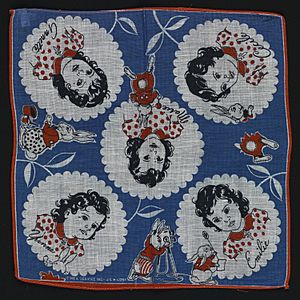
About 3,000 people visited the observation gallery every day. This gallery surrounded the outdoor playground where the sisters played. There was plenty of parking. Almost 3 million people visited between 1936 and 1943. Oliva Dionne ran a souvenir shop and a wool store across from the nursery. The area became known as "Quintland."
Souvenirs with the sisters' pictures included autographs, photos, spoons, cups, plates, candy bars, books, postcards, and dolls. Free stones from the area were given out. People believed these stones had magical powers for fertility. Women without children even touched Oliva Dionne, hoping it would help them have babies. The quintuplets brought in over $50 million in tourist money for Ontario. Quintland became Ontario's biggest tourist attraction. It was even more popular than Niagara Falls in Canada.
Hollywood stars like Clark Gable and Bette Davis visited Callander to see the Quints. Amelia Earhart also visited just weeks before her last flight in 1937. Only five people could be in a room with the quintuplets at one time. These visitors were sprayed with disinfectant.
The sisters, their images, and Dr. Dafoe were used to advertise many products. These included Karo corn syrup, Quaker Oats, Lysol, Palmolive soap, and Colgate. They helped sell condensed milk, toothpaste, disinfectant, and candy bars.
Their Film Careers
The Dionne girls starred in three Hollywood movies. These films were made-up stories based on their lives. They played the "Wyatt quintuplets" in all three movies:
- The Country Doctor (1936)
- Reunion (1936)
- Five of a Kind (1938)
In the first two movies, the Dionne quintuplets mostly just appeared. They didn't really act. Their scenes were filmed at Quintland. They mostly played and interacted like normal children. These movies focused more on the fictional doctor who cared for the Wyatt quintuplets.
The Dionne quintuplets also appeared in many newsreels. They were in a short documentary film called Five Times Five in 1939. This film was even nominated for an Academy Award for Best Short Subject (Two-reel). In 1942, they appeared in a travel film called Land of the Quintuplets. In 1998, the three surviving sisters, Cécile, Annette, and Yvonne, were in a documentary. It was called "Full Circle: The Untold Story of the Dionne Quintuplets."
Their Trust Fund
The quintuplets' trust fund grew quickly. Money came from newspapers and newsreels that featured them. For example, a photographer signed a contract that put $10,000 into their fund. This meant no one else could photograph the girls for a year. Each newsreel made by Pathé News added $12,000 to $15,000 to the fund. A doll company offered the quintuplets five percent of its sales. Many people bought dolls that looked like the quintuplets. By their second birthday, their bank account had $250,000.
Even though the Canadian government managed their trust fund, the quintuplets did not live a rich life. They received $746 each month. The money in their trust fund went down over time. It was used for things like marriages, houses, and child support. It was later found that their trust fund had less money than what was earned from advertisements and photos of them. The government used the quintuplets' trust fund to pay for research, food, and travel for photographers and filmmakers.
When the sisters wrote a book about their difficult childhood, the government did not react much. They did not seem to care about the suffering their actions caused. The sisters asked the Canadian government for $10 million but got no answer. Later, it was revealed that documents about the quintuplets from 1934 to 1937 had been burned. After this news, Premier Mike Harris offered the three living sisters $2,000 per month. The sisters felt this offer was an insult. They wanted what was taken from their trust fund. They took their story to the media. The sisters turned down offers of $2 million and $3 million. They finally accepted $4 million and a review of their trust accounts. Premier Harris visited the sisters and apologized on behalf of the government. The quintuplets finally shared their story with the public and challenged the Ontario government.
Returning to Their Family
By 1939, Dr. Dafoe had stopped being a guardian. Oliva Dionne gained more support to reunite his family. Their parents worked hard to get custody back. Also, the Catholic Church and French-speaking communities pressured the government. This pressure came because the Dionnes had never agreed to their children being taken away.
In 1942, the Dionne family moved into the nursery with the quintuplets. They waited there for their new home to be finished. In November 1943, the whole Dionne family moved into their new house. This large, yellow brick, 20-room mansion was paid for from the quintuplets' fund. The home had many luxuries for that time. These included telephones, electricity, and hot water. It was called "The Big House." Today, this building is a retirement home.
The nursery building was later turned into a school. The sisters finished their high school education there. Ten other Roman Catholic girls from the area also attended. In later years, the old Dafoe Hospital was used as a convent.
When the family was reunited, they faced many challenges. They were not a happy family. The quintuplets felt distant from their siblings. They struggled to talk to each other. The quintuplets spoke French, but their siblings preferred English. Once Oliva got custody, he wanted attention. He had police escort his car when he took the quintuplets out. This constantly drew attention to them and to himself.
Their parents said they wanted to make the quintuplets part of the family. However, the sisters often traveled to perform at events. They still dressed the same. The surviving sisters said their parents often treated them as a group of five. They were often lectured about the trouble they had caused by being born. For many years, they did not know that their lavish house, expensive food, and cars were paid for with their own money. They knew their upbringing meant they would never feel truly part of the large Dionne family. They called their time in the Big House "the saddest home we ever knew."
Their Adult Lives
The quintuplets left their family home when they turned 18 in 1952. After that, they had little contact with their parents. Three of them got married and had children. Marie had two daughters. Annette had three sons. Cécile had five children, including twins. One of Cécile's children died as a baby.
Émilie spent her short life trying to become a nun. Yvonne finished nursing school. She then became a sculptor and later a librarian. Émilie died at age 20 from a seizure. She had seizures at a convent. She had asked not to be left alone. But the nun watching her thought she was asleep and went to Mass. Émilie had another seizure, rolled onto her stomach, and could not lift her face from her pillow. She accidentally suffocated. In 1970, Marie was living alone. Her sisters worried when they did not hear from her for several days. Her doctor found her dead in bed. She had been dead for days. A blood clot was found in her brain.
Annette and Cécile both later divorced. By the 1990s, the three surviving sisters lived together. They lived in the Montreal suburb of Saint-Bruno-de-Montarville.
In 1965, author James Brough wrote a book with the four surviving sisters. It was called We Were Five. Pierre Berton wrote a biography called The Dionne Years: A Thirties Melodrama in 1977. He also narrated a 1978 documentary. John Nihmey and Stuart Foxman wrote a fictional book in 1986. It was called Time of Their Lives – The Dionne Tragedy. This book was used for the 1994 TV miniseries Million Dollar Babies.
In 1997, the three surviving sisters wrote an open letter. It was to the parents of the McCaughey septuplets. They warned against too much publicity for the children. After this, they reached a $4 million agreement with the Ontario government. This was as payment for how they were used.
As of 2022, two sisters are still living: Annette and Cécile. Yvonne died in 2001.
Museums About the Quintuplets
The original family farmhouse was moved around 1960. It was moved again in 1985 to North Bay. It was turned into the non-profit Dionne Quintuplets Museum. The museum shows many items from the girls' early days and growing years. In October 2016, the museum closed. The city of North Bay thought about selling the building. But people wanted it saved as a historical building. In 2017, plans were made to move the house to a fairground in Sundridge. On November 9, 2017, the City of North Bay announced plans to move the house to a new spot in downtown North Bay. It reopened in spring 2019.
A second museum, the Callander Bay Heritage Museum, also has many items from the Dionne quintuplets. It is located in the old home of Dr. Dafoe.
Images for kids
See also
 In Spanish: Quintillizas Dionne para niños
In Spanish: Quintillizas Dionne para niños


